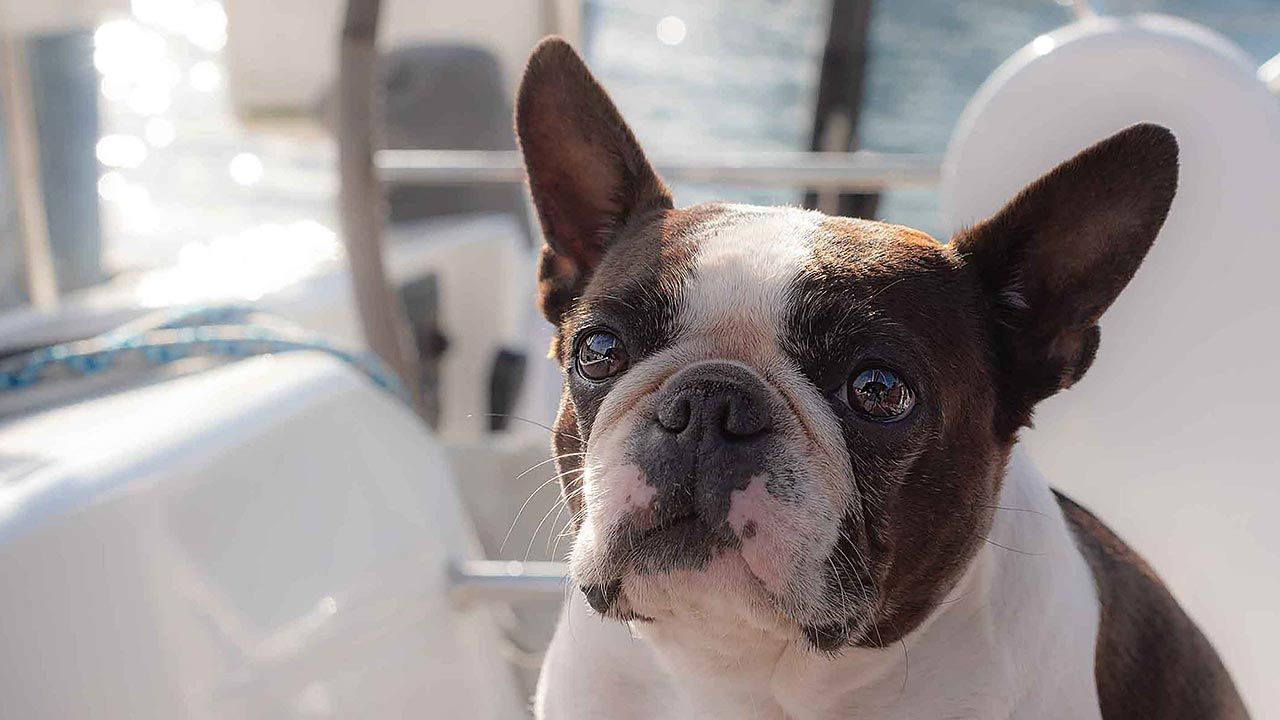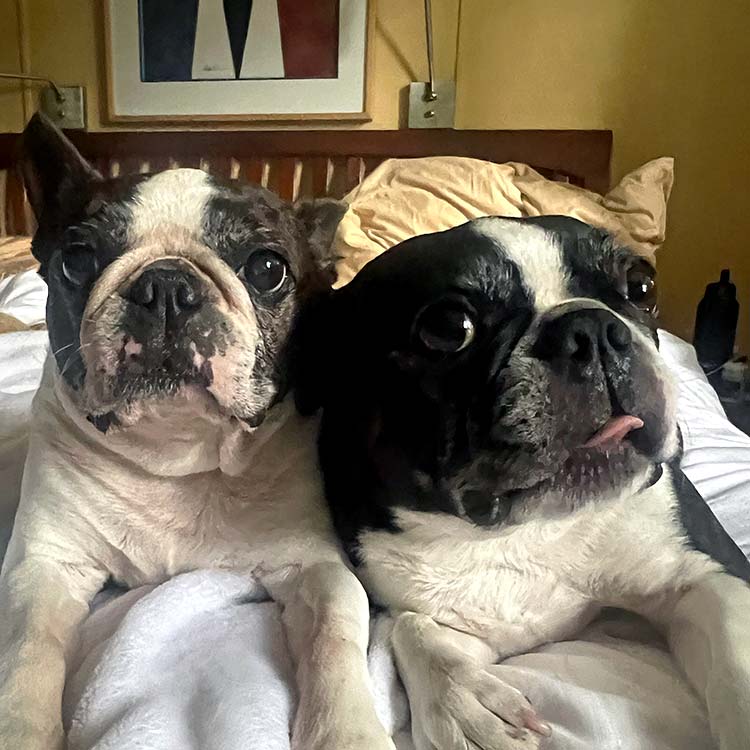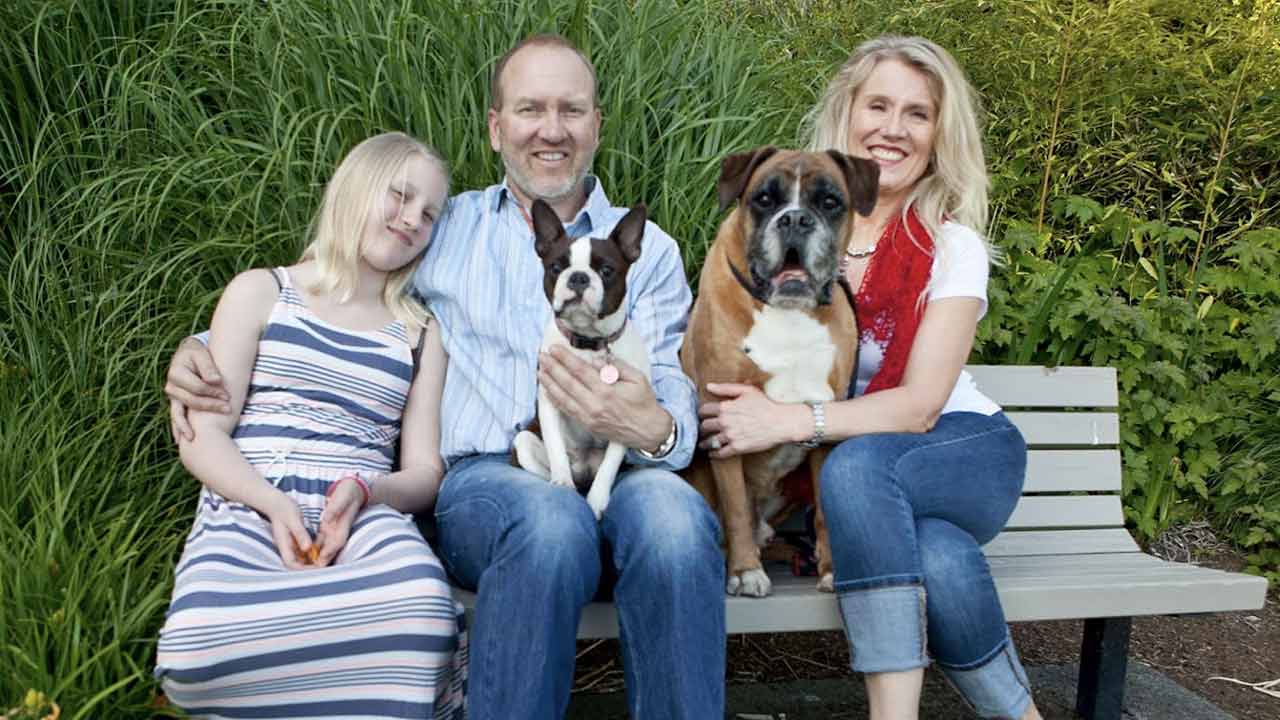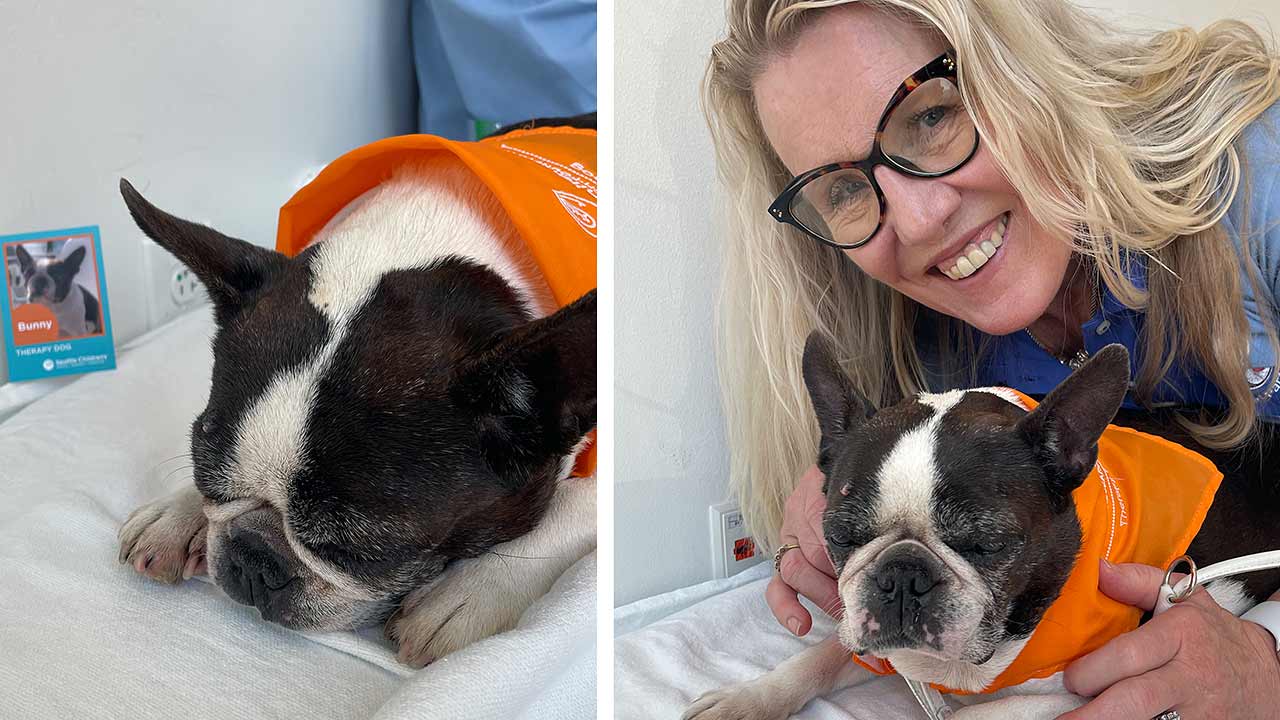Healing Pet Loss Guilt: How My Dog Bunny’s Death Inspired the A.C.T. Framework for Pet Parents
Nov 14, 2025
Healing Pet Loss Guilt: How My Dog Bunny’s Death Inspired the A.C.T. Framework for Pet Parents
By Michelle Nichols, MS, HonCAHP, CGRS | Animal Hospice Coach, Educator, Mentor, and Certified Grief Recovery Specialist, AHELP Founder
When we lose a beloved animal family member—especially in a way that feels sudden, preventable, or unimaginable—we enter a landscape where guilt and grief blur together. I’ve coached hundreds of pet parents through this terrain, guiding them along what we call the Path of Least Regrets. But last year, on an ordinary autumn day as the leaves burned bright against Seattle’s gray skyline, I found myself stepping onto that path not as a coach, but as a grieving mom. I wrote a short memorial post about Bunny not long after her passing, but this is the story of our girl’s death, what it taught me about justified guilt, and how it reshaped the way I help others find their way back to healing.
💔 The Accident
November 14, 2024, was a tragic Fall day that will forever be indelibly etched in my memory.
I fed my Boston Terriers, Teddy and Bunny, their usual pieces of chicken for dinner—something I’d done countless times before. I stepped back to my office, just 20 feet away, to complete a work deadline before dinnertime. Just fifteen minutes later, when I returned, I found Bunny lying on her side, very still. Teddy stood frozen, staring at her. We were all stunned, but it was clear what had happened.
Chris and I rushed to help—clearing her airway, giving dog mouth-to-mouth resuscitation, begging for her to come back—but it was too late. The shock was overwhelming. I saw Teddy’s confusion and imagined what he had witnessed. I even saw Chris shed what might have been his first tear in years.
We called our daughter, who was studying at Washington State University, and explained quickly that she needed to say goodbye to Bunny, reminding her that the last sense to go was hearing. “Don’t worry that you’re crying, she knows how much you loved her.” Through our sobbing, Zoe and I tried to make sense of it, while Chris and I clung to one another and hugged Bunny’s lifeless little body. 🐾🌈🐰♥️
🕊️ The Aftermath
I moved through what I knew so well: creating a peaceful space for Bunny to lie in state, honoring her just as I’d helped many families honor their beloved animals. For two days, Bunny lay in quiet dignity, giving us time to say goodbye before we brought her to Compassion 4 Paws in Mountlake Terrace, WA, for aquamation.
And then the guilt came. Despite years of teaching others how to prepare for loss and cope with grief, I found myself circling the familiar woulda–shoulda–couldas:
1️⃣ - I shouldn’t have left them alone while eating; I knew a chunk of meat was riskier than kibble.
2️⃣ - I should have prepared their meal more carefully; cutting the chicken into small pieces would have taken seconds.
3️⃣ - I should have recognized Bunny’s aging needs; if I’d checked her mouth regularly and noticed missing teeth, as is common in brachycephalic dogs, I might have taken precautions.
A lifetime of loving and living with dogs and cats would somehow protect me from this kind of pain, I thought. But loss humbles even those who live closest to it.
🌅 Lifting Myself from Guilt to Healing
The truth is, Bunny’s death didn’t hit an empty landscape. Two months earlier, I had gone “head-down” updating my Partners to the Bridge Coaching and reimagining how to help better pet parents navigate the emotions of animal end-of-life. That work led me deep into the teachings of Positive Psychology—an approach that looks at grief through a lens of resilience and possibility.
Dr. Lucy Hone’s book Resilient Grieving: How to Find Your Way Through a Devastating Loss struck me in a way I didn’t expect. As she had done after the tragic loss of her daughter, I knew in my heart that this grief would not shatter my family. Her work helped me see that we still had agency—small steps we could take to heal, even when nothing about the loss itself could be changed.
From my work as a Grief Recovery Method Specialist, I knew the first step in healing for animal caregivers is distinguishing between unjustified and justified guilt.
Most guilt I’d helped others face over the years—illness, aging, the natural end of a senior pet’s life—was unjustified. With time and reflection, families could recognize that circumstances beyond their control caused these losses.
Justified guilt is different. It stems from preventable harm: an accident, oversight, or lapse in judgment. Though rarer, it’s heavier and more complex. The sense of responsibility makes self-forgiveness feel out of reach.
This is where I found myself. To keep moving, I had to reframe my justified guilt into regrets—real, painful regrets about decisions made and moments missed. And I had to find a structured, compassionate path forward for my family and for myself.
So I leaned into ritual. I printed our favorite photos of Bunny, and together we held a small ceremony that emerged naturally. We chose the images we loved most. We took turns sharing memories, and I wrote each one down. I used to love scrapbooking, and for the first time in years, the prospect of creating a memorial photo book felt grounding.
Photo caption: Bunny at age 3 in our family photo with Zoe, Chris, and Rex at the Enatai Beach Park.
⌛One Year Later…
That was precisely one year ago. My husband, my daughter, Teddy, and I were devastated—haunted by the feeling that Bunny’s death might have been preventable and that she deserved so much better.
We were beginning to heal, but I still couldn’t speak our accountability without shame. So I carried the truth quietly, inching toward self-forgiveness and slowly rebuilding my sense of worthiness as a responsible pet mom.
🧭 The Turning Point: From Grief to a Path Forward
In the months that followed, something slowly took shape. My family and I weren’t just grieving Bunny—we were learning how to live with the guilt without letting it swallow us whole. And as I knew with other pet parents, we weren’t alone. So many people who’d experienced accidental or preventable loss carried the same quiet shame, the same fear of being judged, the same ache of “If only…”
It became clear that justified guilt needed a different kind of support—more structured, more intentional, and more compassionate than the tools I had offered before. Everything I had learned from Positive Psychology, grief work, hospice philosophy, and my own lived experience was pointing in the same direction:
- Healing wasn’t going to come from erasing guilt.
- It would come from working with it—gently, honestly, and bravely.
That realization stayed with me. It tugged at me during coaching sessions, during conversations with colleagues, and especially in the quiet moments when I looked at our favorite photos for Bunny’s Memory book. I began to wonder whether there was a way to guide people through this process with clarity and purpose. Not to rush them, not to minimize their pain, but to offer a way forward—one step at a time.
Slowly, a pattern emerged.
Every caregiver I’d supported who moved from guilt to healing—even those facing justified guilt—had navigated three essential stages. And I had just lived them myself. Those stages became the foundation of a process I now call The A.C.T. Framework: Accountability + Action → Create Change → Transformation.
The A.C.T. Framework for Healing from Pet Loss Grief
The lessons I drew from that altogether awful but enlightening time last year became the foundation for my A.C.T. Framework—a process I developed not only to help others heal, but to guide myself and my own family through grief, forgive myself, and rebuild that sense of worth. It begins with the first, and often the hardest, step:
💙 A — Accountability and Action
Healing began the moment I said out loud, “I should have been more careful in feeding Bunny.” I’ll be clear—I am not superhuman. Believe me, I felt a certain amount of shame, and that’s why I didn’t share this raw, transparent account until a full year later. But I owed it to her, and to you, fellow pet parents. I suspect that once this is published, I’ll also feel a certain sense of relief now that I’ve fully accepted accountability—whatever the repercussions.
ACCOUNTABILITY isn’t about punishment—it’s about honesty and love. When we face what happened without turning away, compassion can finally take root. 🌱
The framework flowed so easily because we had already taken the first step. In her book, which had resonated with me for over a year, Dr. Lucy Hone presented what she learned from the experts at the University of Pennsylvania's Positive Psychology Center. Most people naturally possess the ability to heal from grief—or can understand and apply those skills. Her teachings emphasized that recovery requires ACTION—not the frantic kind, but small, deliberate steps that help us keep living meaningfully in the face of loss.
The action I took was applying lessons from Resilience Psychology to my own life and helping my family navigate theirs. Those small steps—naming the pain, finding daily moments of comfort, allowing gratitude to return—gave structure and purpose to our grief. In that space, healing quietly began.
Photo caption: Bunny and Michelle volunteered with the Pet Partners Animal-Assisted Therapy Team at Seattle Children's Hospital.
💚 C — Create Change
The CHANGE was sharing Bunny’s story openly so others might learn from my regrets—particularly around feeding a senior dog safely as they age gracefully, just as our Bun had done every day of her life with us, up to that fateful day.
It was a shock that everything had been going so well in her aging process; we had been so attentive, so proud of how she was thriving. Sharing her story became a way to transform my remorse into something useful for others.
I’ve also spoken more about the joy Bunny and I found together as a Pet Partners Animal-Assisted Therapy (AAT) team at Seattle Children’s Hospital. It was tough to email them to tell of her unexpected death but I could pass it off on a heart murmur I had explained had been tiring her more easily as of late.
Though we were a registered team for 5 years, our volunteering at the hospital lasted less than 1 year before the pandemic halted visits to sensitive settings. Still, our prior experiences, reading at the Seattle City Library System, had also brought light to so many children and left a lasting imprint on my heart.
I know I’ll never return to AAT volunteering—because there will never be another dog quite like “Bunny the Boston Terrier,” as they called her—but that chapter’s lessons continue to guide how I connect with families through pet hospice coaching and pet caregiver support.
💛 T — Transformation
I knew TRANSFORMATION would come if I adapted the resilient grieving principles I had learned from Dr. Hone to healing from pet loss. I felt more confident in myself when I realized, even a week after our Bunny Memorial Photo Ceremony, that I was feeling better, much sooner than I expected. Heading into the holidays, I assumed our family would be devastated—that the season would be shadowed by loss instead of light. But it wasn’t.
At Thanksgiving, we had expressed gratitude for the years we shared with Bunny. When we decorated for Christmas, we hung her stocking in the familiar place next to ours, then filled it for Christmas morning. Teddy, now an “only child,” delighted in keeping all the toys and treats for himself. We shared pictures, told stories, and remembered her with love instead of pain as we all sipped champagne and peppermint hot cocoa.

Photo caption: Bunny hanging out with BFF, Teddy, on the bed. |
Don’t get me wrong–it’s still tough and my heart aches for our “Bun” every day. As I gaze at her portrait on the table next to the dog bed where Teddy lay there by himself, there is a lump in my throat and a tear in my eye. I am reminded that transformation doesn’t erase grief—it reshapes it, and our beloved pets move from beside us to within us, guiding us still. 🌈 |
Photo caption: Bunny and I had many adventures together. Photo on the left - Bunny was always a crowd favorite as a Flyball Dog! (Seattle Kennel Club Dog Show 2016). Photo on the right - In her youth, Bunny and I used to love to go on nature hikes at Luther Burbank Park on Lake Washington.
❣️Finding Peace on the Path of Least Regrets
The A.C.T. Framework isn’t about erasing guilt—it’s about growing through it.
✨ Accountability and Action bring clarity.
✨ Creating Change gives meaning.
✨ Transformation keeps love alive.
In coaching pet parents and listening to the many experiences shared through Pet Hospice Tails, I often remind families that, just as in birth, death is unpredictable. Regrets will arise. When they do, I encourage them to offer themselves grace and forgiveness. I’m deeply grateful for every story families entrust to me, because we truly learn from one another.
Lately, as the red, orange, and yellow hues stretch across Seattle’s sometimes-blue, sometimes-gray skies, I can feel the anniversary of Bunny’s passing drawing near. What I would give for that day to have unfolded differently. But the truth is: I have moved beyond guilt. What remains are honest regrets and a gentler path forward.
I didn’t set this story aside or choose an easier topic for this month’s blog. Writing this was the right thing to do—to honor Bunny’s first anniversary and to offer other conscientious pet parents a place to find comfort, understanding, and perhaps a softer way through their own grief. 🕯️
Please tune in next month when I share more of my personal journey through pet love and loss—the “Tail” of Brodie, who died in December 15 years ago. His was our family’s first true experience in comfort care and animal hospice, and it became the turning point that led to the founding of the AHELP Project. 🐾🌈👣♥️
( Blog post banner: Photo of sweet Bunny on our boat, photo credit to Holly Cook Photography. )
|
About the Author: Michelle NicholsAs an Animal Hospice Coach and Educator—a Pet Hospice Partner—I have the privilege of supporting families through one of life’s most sacred and challenging passages: accompanying a beloved dog or cat in their final chapter. My goal is to offer not only practical guidance but also emotional support and a deeper way to relate to this time—not just as an ending, but as a meaningful, even healing experience. With 30 years of combined experience in human and pet-related grief counseling, I continually refine my skills to serve pet parents best and to help prepare the next generation of pet hospice leaders through education and mentorship. My virtual door is always open. Reach me at [email protected]. |
Join Our Newsletter List!
You’ll receive the latest blog posts, useful tools, and plenty of inspiration. As a special gift, you'll receive a FREE Handout Combo download of Animal Quality of Life Indicators to Report to Your Veterinarian AND 40+ Questions to Ask Your Veterinary Team—both a valuable resource!





